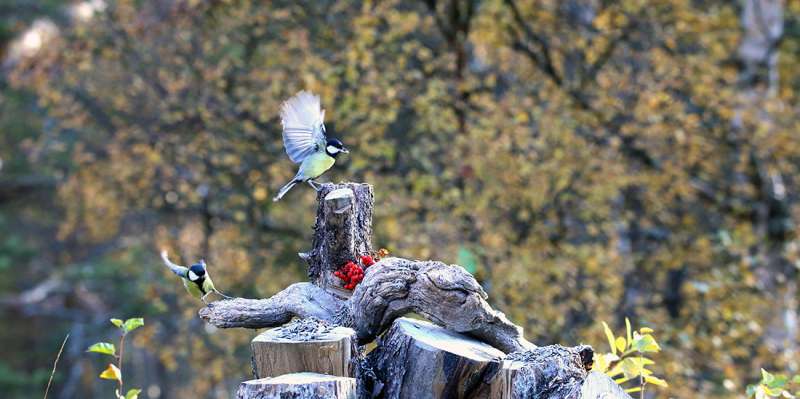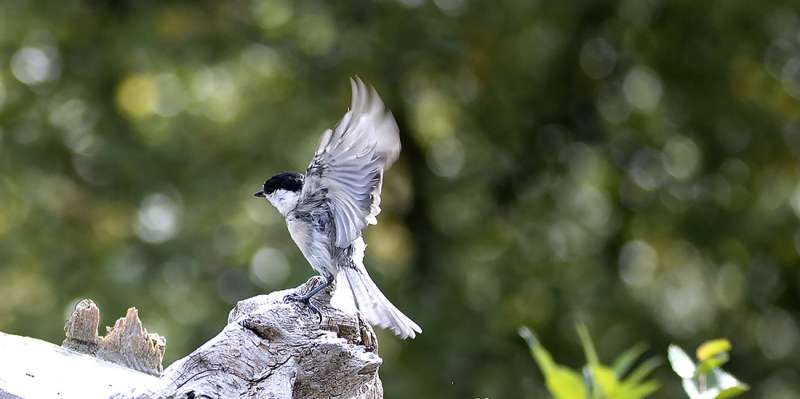Small birds discern threat level of enemies

Chickadees and titmice don't just see that another bird is dangerous. They can also differentiate species and tell just how much of a threat they are.
In winter, the most important thing for northern birds is to avoid starvation. The days are short and they use almost all their daylight hours to find food.
At the same time, they have to be alert to the ever-present threat of birds of prey and other enemies.
The birds also need to conserve energy, so they can't be making unnecessary escapes. They have to be able to distinguish between birds that are dangerous and ones that don't pose a threat.
Professor emeritus Olav Hogstad is affiliated with NTNU's Department of Natural History and has been studying small birds' reactions to various birds. He put Eurasian Blue, Great and Willow Tits to the test to see if they could discern the difference between threatening and harmless species.
Hogstad exposed the tits to life-like stuffed models of the Eurasian Sparrowhawk, Siberian Jay and Three-toed Woodpecker when they were at a feeder. Both the Sparrowhawk and Siberian Jay consider the tits prey, whereas the Siberian Jay is completely harmless to them. The hawk model was a male, which is much smaller than the female, making the three birds similar in size.
Not unexpectedly, the small birds did not respond very much to the woodpecker. But they reacted differently to their two enemies.
When small birds discover a predator, they can send a warning signal to other individuals of the same species to alert them. They can then cooperate by making the bird of prey aware that it's been discovered and that it might as well move somewhere else. They fly around the dangerous enemy and make a commotion. This is called mobbing behaviour.

The hawk triggered more mobbing behaviour than the jay did. Yet the tits took much longer to come back to the bird feeder after Hogstad removed the potential jay threat.
"Clearly, the tits are able to see the differences between the various predator threats, and they make decisions based on their perception of the threat level," says Hogstad.
The tits seem to regard the hawk as a bigger threat than the jay, despite the fact that jays can also kill them. But the jay is more of an opportunist that can feed on other things than meat if conditions are right, while the Sparrowhawk is a purely carnivorous.
Interestingly, the smaller Blue tits returned to the feeder more quickly than the Great tits did after presenting the Siberian Jay.
The Blue tits apparently were willing to accept a higher threat level than Great tits. The Blue tits could be described as being braver, and taking more time to eat than making sure the danger is past, but they might also be more prone to being eaten.
The tits live in small flocks in the winter. The socially dominant males returned to the feeder sooner than did the subordinate females, and the males would often first check for enemies. This may be to protect their mates.
But the birds of lower rank began to resume their foraging activity earlier than the dominant birds. This may be because they are hungrier to start with and have to take a higher risk so they don't starve to death.
"The dominant birds are basically eating better and can afford to spend more time checking for enemies and assessing the predation risk before they dig in at the feeder," said Hogstad.
All in all, Hogstad says, the tits appear to be able to perceive and assess predator threat levels, and adjust their behaviour accordingly.
More information: Olav Hogstad. Predator discrimination and anti-predator behaviour by wintering parids: an experimental study, Ornis Norvegica (2017). DOI: 10.15845/on.v40i0.1320
Provided by Norwegian University of Science and Technology (NTNU)



















